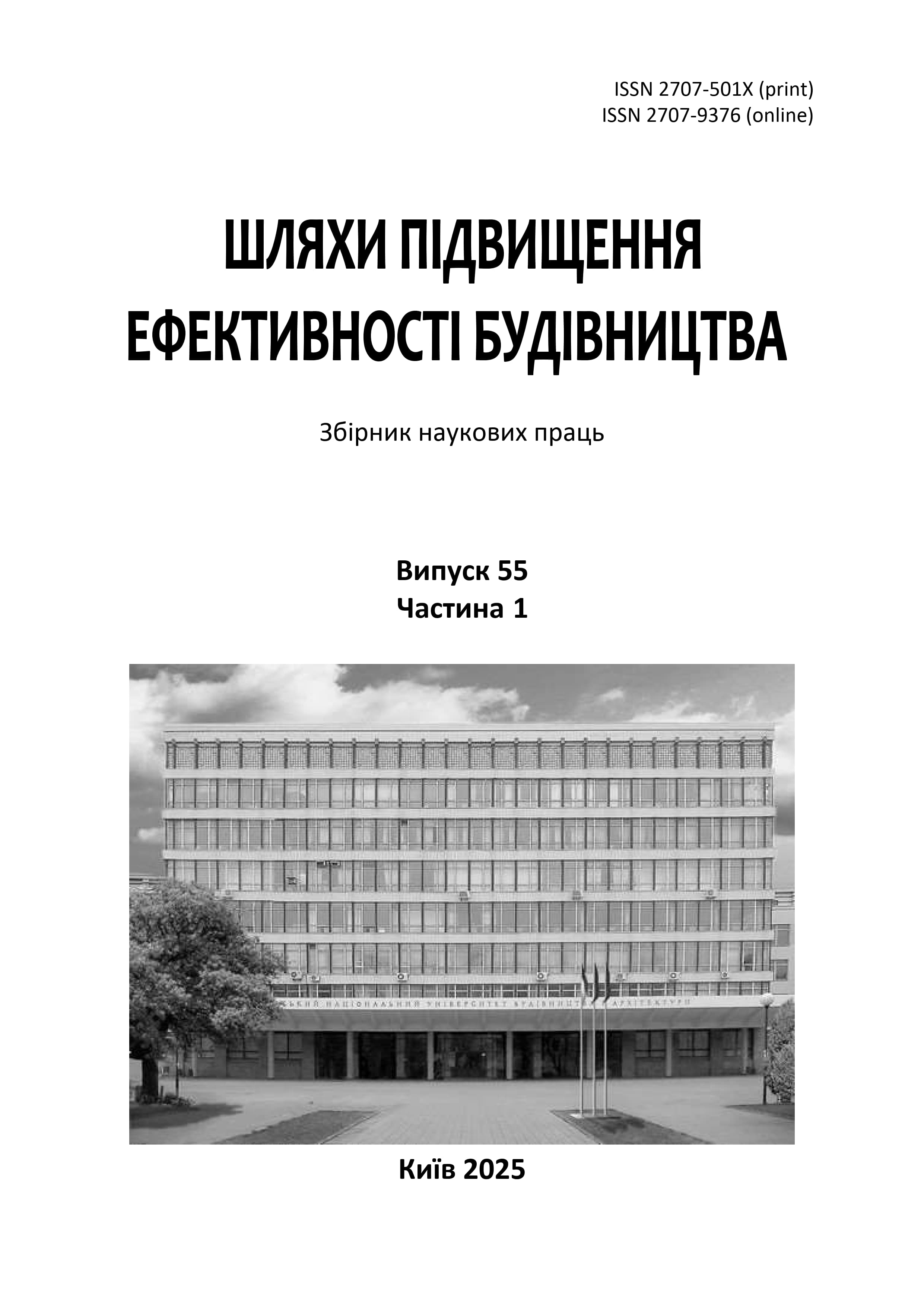Determination of reinforcement depth for low-energy dynamic compaction construction in high-fill engineering in mountainous areas
DOI:
https://doi.org/10.32347/2707-501x.2025.55(1).70-84Keywords:
Mountain engineering, Fill compaction, Effective reinforcement depth, Influence depth of reinforcement, Calculation formulas, Dynamic compaction testsAbstract
Dynamic compaction technology has gained rapid development and widespread application in soft soil reinforcement due to its numerous advantages. This study investigates low-energy dynamic compaction commonly used in high-fill mountain engineering, detailing its construction processes and engineering applications while systematically reviewing current theories and advancements in determining reinforcement zones. However, existing methods for defining effective reinforcement depth still rely heavily on construction experience and trial section testing, resulting in cumbersome procedures, high data dispersion, and insufficient reliability. To address this, the authors established a clear distinction between "effective reinforcement depth" and "influence depth of reinforcement" based on the "ellipsoidal morphology" assumption. Starting from the principle of equal soil mass before and after compaction (neglecting air mass), a complete set of calculation formulas for both depths was derived. The derivation process incorporated both compaction parameters (e.g., energy level, tamping frequency) and intrinsic soil properties (e.g., initial density, Poisson’s ratio). These formulas enable efficient computation of reinforcement depths when inputting known parameters, offering a novel approach to evaluate reinforcement effectiveness and optimize compaction strategies for low-energy projects. Furthermore, a series of low-energy dynamic compaction tests with varying energy levels were designed and implemented in a northwestern Chinese high-fill project. Field measurements of single-blow and cumulative settlements, effective reinforcement depths, and influence depths were collected and compared with formula-calculated results, confirming the formulas’ accuracy and engineering reliability. The methodology and outcomes provide a research paradigm for similar projects and enrich the theoretical basis for evaluating soft soil reinforcement using dynamic compaction technology.
References
Liu, G., Zhang, Q., & Chen, W. (2020). Empirical-experimental evaluation of effective depth in dynamic compaction for coastal reclamation projects. Soil Dynamics and Earthquake Engineering, 137, 106299. https://doi.org/10.1016/j.soildyn.2020.106299
Deng, J., Wang, S., He, S., et al. (2025). Dynamic response and densification mechanism of dynamic compaction for silt soil through a large-scale field test at Daxing Airport. Soil Dynamics and Earthquake Engineering, 190, 109201. https://doi.org/10.1016/j.soildyn.2024.109201
Koohsari, H., Alielahi, H., Najafi, A., et al. (2023). The application of artificial intelligence methods to optimize improvement depth of dynamic compaction. Computers and Geotechnics, 150, 105432. https://doi.org/10.1016/j.compgeo.2023.105432
Yang, K., Wang, H., Wang, K., et al. (2024). An effective monitoring method of dynamic compaction construction quality based on time series modeling. Measurement, 224, 113930. https://doi.org/10.1016/j.measurement.2023.113930
Li, J., Bai, X., & Ma, F. (2020). Energy transfer and influencing factors in soil during compaction. PLOS ONE, 15(11), e0242622. https://doi.org/10.1371/journal.pone.0242622
Wang, J., Cui, Y., & Li, Q. (2019). Hybrid numerical investigation on soil-hammer interaction during dynamic compaction. Advances in Civil Engineering, 2019, 4563134. https://doi.org/10.1155/2019/4563134
Liu, Y., Zhao, M., Wu, C., et al. (2020). Coupled discrete-continuous simulation and analysis of dynamic interactions between hammer and pavement. China Journal of Highway and Transport, 33(10), 13-25. https://doi.org/10.19721/j.cnki.1001-7372.2020.10.009
Zhu, C. H., & Li, N. (2024). A critical review of empirical formulas and theoretical models for predicting effective reinforcement depth in dynamic compaction. Computers and Geotechnics, 163, 105789. https://doi.org/10.1016/j.compgeo.2023.105789
Wang, T., Hu, L., & Ng, C. W. W. (2022). Limitations of empirical methods in dynamic compaction design for stratified fill and anisotropic stress conditions. Computers and Geotechnics, 148, 104825. https://doi.org/10.1016/j.compgeo.2022.104825
Liu, C., Zhang, G., & Wang, Y. (2022). A comparative study of wave equation and finite element methods for dynamic compaction analysis: Sensitivity, computational efficiency, and engineering implications. Computers and Geotechnics, 145, 104678. https://doi.org/10.1016/j.compgeo.2022.104678
Jia, B., Jing, L., Bu, G., & Liu, F. (2019). Theoretical derivation and implementation of pseudo-static method for seismic analysis of underground structures. IOP Conference Series: Earth and Environmental Science, 304(4), 042026. https://doi.org/10.1088/1755-1315/304/4/042026
Chen, Z., Wang, L., & Liu, Y. (2021). A generalized ellipsoidal model for dynamic compaction zones in cohesionless soils: Validation via field and numerical experiments. Computers and Geotechnics, 138, 104324. https://doi.org/10.1016/j.compgeo.2021.104324
Wang, H., Li, J., & Zhao, Y. (2022). Gas migration and volumetric response in saturated-unsaturated soils subjected to high-energy impact compaction. Journal of Geotechnical and Geoenvironmental Engineering, 148(9), 04022067. https://doi.org/10.1061/(ASCE)GT.1943-5606.0002875
Xu, L., Zhou, J., & Zhang, F. (2023). Mass conservation and pore structure evolution in dynamic compaction of unsaturated silty clay. Computers and Geotechnics, 162, 105678. https://doi.org/10.1016/j.compgeo.2023.105678
Jia, B., Jing, L., Bu, G., & Liu, F. (2024). Experimental and numerical analysis of bidirectional soil pressure distribution in dynamic compaction model tests. Journal of Geotechnical Engineering, 172(3), 04024012. https://doi.org/10.1061/JGTE.2024.04024012
Li, X., Zhang, Y., & Wang, Z. (2024). A comprehensive theoretical framework for dynamic compaction design integrating multi-factor coupling effects. Computers and Geotechnics, 168, 106102. https://doi.org/10.1016/j.compgeo.2024.106102
Downloads
Published
How to Cite
Issue
Section
License

This work is licensed under a Creative Commons Attribution 4.0 International License.
Authors who publish with this journal agree to the following terms:
- Authors retain copyright and grant the journal right of first publication with the work simultaneously licensed under a Creative Commons Attribution License that allows others to share the work with an acknowledgement of the work's authorship and initial publication in this journal.
- Authors are able to enter into separate, additional contractual arrangements for the non-exclusive distribution of the journal's published version of the work (e.g., post it to an institutional repository or publish it in a book), with an acknowledgement of its initial publication in this journal.
- Authors are permitted and encouraged to post their work online (e.g., in institutional repositories or on their website) prior to and during the submission process, as it can lead to productive exchanges, as well as earlier and greater citation of published work (See The Effect of Open Access).

